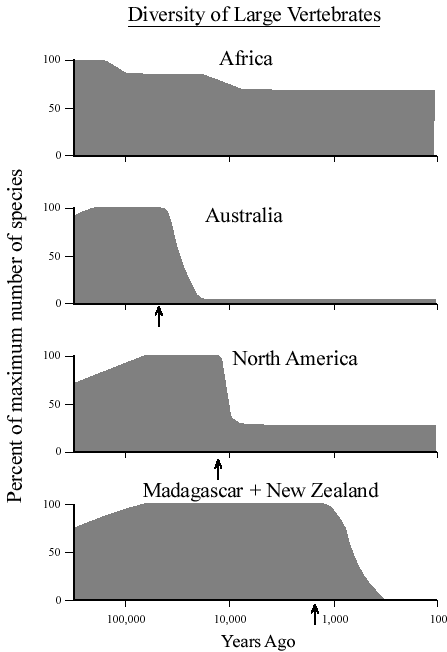
One last note on Extinction:
Sometimes, a particular group will experience a lot of extinction, unrelated to what is happening with other groups.
During the past 100,000 years, there have been a number of extinctions of large vertebrates (principally mammals and large birds) on different continents.
These events correspond closely to the arrival of Humans.
In the following figure, the arrows indicate the approximate time of arrival
of humans.

Human Evolution
Closest living relative of Chimpanzees.
Common ancestor with chimps ~6-7 mya.
Some differences between Humans and Other Apes:
Walk upright
Increased brain size
Extensive technology
Language
Extended "childhood".
Some members of the human side of the clade:
Until recently, there was practically no fossil record of human
ancestors before about 3.6 mya.
This is beginning to change as new fossils are discovered from the
5-6 mya period.
It now appears that walking upright arose very early and
in forested habitats.
This contradicts the earlier supposition that hominids became
upright when they moved into open savannas.
Orrorin
Discovered in 2000 in Kenya.
Dates to ~6 mya, but limbs resemble modern humans more than do those of Australopithicus.
Walked upright, but lived in forested areas.
Australopithecus
This genus contained a number of species, some of which persisted from at least 3.6 mya until around 1 mya.
Walked upright.
Relatively small braincase (compared to later hominids) and an elongate
face.
A. afarensis dates from at least 3.5 mya. (Includes "Lucy").
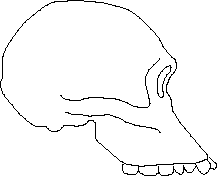
Cranial capacity increased from ~400cc to ~450cc from early to later Australopithicenes.
The genus Homo
Early Homo
H. habilis (~2.5-1.7 mya) had a somewhat larger brain (600-800 cc)
and less protruding face than Australopithecines.
These were the first serious users of stone tools.
Flakes and flaked pebbles.
H. erectus
(Sometimes called H. ergaster)
Appears ~1.9 mya and persisted until 150,000 years ago or less (perhaps 70,000ya).
Fossils from Africa and central Eurasia appear at about the same time (~1.8 mya).
By 1.2 mya, had migrated throughout Africa and into China and Southeast Asia.
These made much more extensive use of stone tools, with distinct
types of tools.
Cranial capacity increased from ~900cc in the earliest H. erectus to ~1,100cc in the later ones.
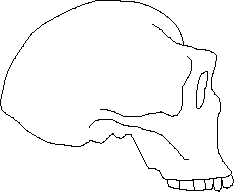
H. floresiensis
Probably an offshoot of H. erectus.
Found on the island of Flores (part of Indonesia).
Persisted up until around 50,000 years ago. (Originally thought to be up to about 13,000, but this date appears to have been in error).
Very small (~3.5 ft tall) with relatively small braincase. Similar in size to chimp or Australopithecines, but with the prefrontal cortex more like other Homo.
H. heidelbergensis
Appears in Africs ~700,000ya.
Name sometimes used for late H. erectus
Migrated throughout Africa and into Eurasia.
Led to at least three distinct lineages, Neanderthals, Deniovans and
modern humans.
Neanderthals (~500,000 - ~40,000 ya)
(Early specimens often classified as H. heidelbergensis.)
Primarily European
Neanderthals had relatively good stone tools.
These became more elaborate shortly before extinction.
Coexisted in Europe for some time with Moderns.
Neanderthals had a cranial capacity of ~1500 cc, a bit larger than us.
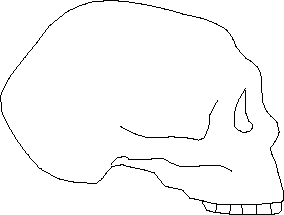
Evidence of culture: A number of Neanderthal fossils show partly healed injuries that were severe enough that other individuals must have taken care of the injured one for some time.
There is also evidence that Neanderthals buried their dead.
Neanderthals appear to have had the same kind of extended childhood that we have, though the entire lifecycle was shorter.
It has recently been shown that Neanderthals were responsible for some cave art.
Language
It is unclear whether or not Neanderthals had language, but there is suggestive evidence that they could have.
Interbreeding
1-5% of modern non-African genomes is derived from Neanderthals.
Not the case for modern Africans (Neanderthals did not migrate to Africa).
Denisovans
Discovered through genetic analysis of bones from the Denisova cave in Siberia.
mtDNA and nuclear genome closer to Neanderthals than to modern humans.
However: ~5% of modern Melanesian genome appears to have been derived from Denisovan genomes.
DNA from ~400,000 year old bones from spain is closer to Denisovans than to Neanderthals, suggesting that they were widespread.
Modern Humans
From populations that arose in Africa 100,000 - 200,000ya and quickly dispersed.
Evidence of elaborate culture, including more sophisticated stone tools
and art, starts to show up ~50,000ya.
This sometimes referred to as the "Human Revolution".
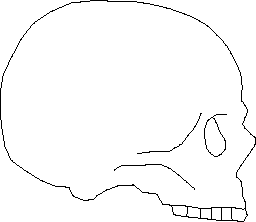
H. sapiens also notable for having a strong tendency to expand their range, including to the arctic and to remote islands.
Morphological trends
The hominid lineage shows some clear directional trends: